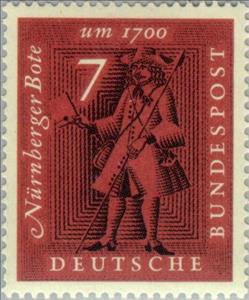Stamp: Nuremberg messenger (about 1700) (Germany, Federal Republic 1961)
Nuremberg messenger (about 1700) (Germany, Federal Republic 1961)
31 August (Germany, Federal Republic ) within release Exhibition ""The letter in the transf. of five cent."" goes into circulation Stamp Nuremberg messenger (about 1700) face value 7 German pfennig
| Stamp Nuremberg messenger (about 1700) in catalogues | |
|---|---|
| Michel: | Mi:DE 365 |
| Yvert et Tellier: | Yt:DE 237 |
Stamp is vertical format.
Stamp Nuremberg messenger (about 1700) it reflects the thematic directions:
Special Occasions
The mail or post is a system for physically transporting documents and other small packages; or, the postcards, letters, and parcels themselves. A postal service can be private or public, though many governments place restrictions on private systems. Since the mid-19th century national postal systems have generally been established as government monopolies with a fee on the article prepaid. Proof of payment is often in the form of adhesive postage stamps, but postage meters are also used for bulk mailing. Modern private postal systems are typically distinguished from national postal agencies by the names "courier" or "delivery service". Postal authorities often have functions other than transporting letters. In some countries, a postal, telegraph and telephone (PTT) service oversees the postal system, in addition to telephone and telegraph systems. Some countries' postal systems allow for savings accounts and handle applications for passports.


